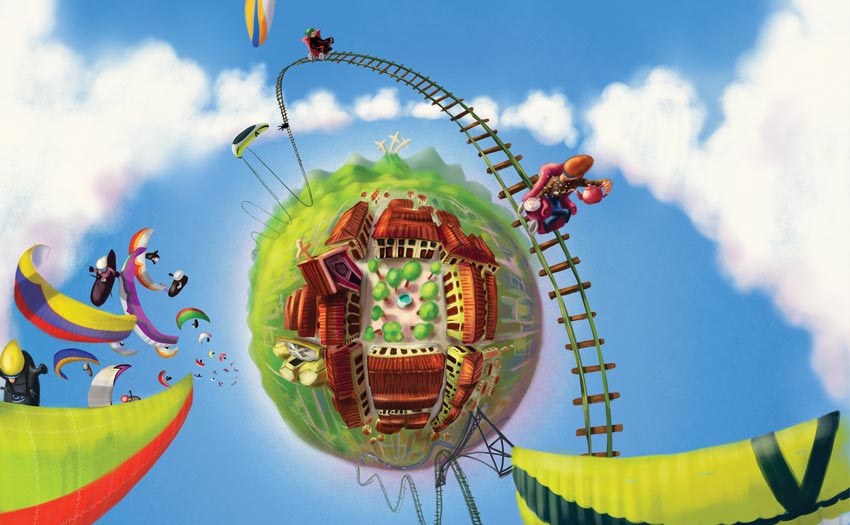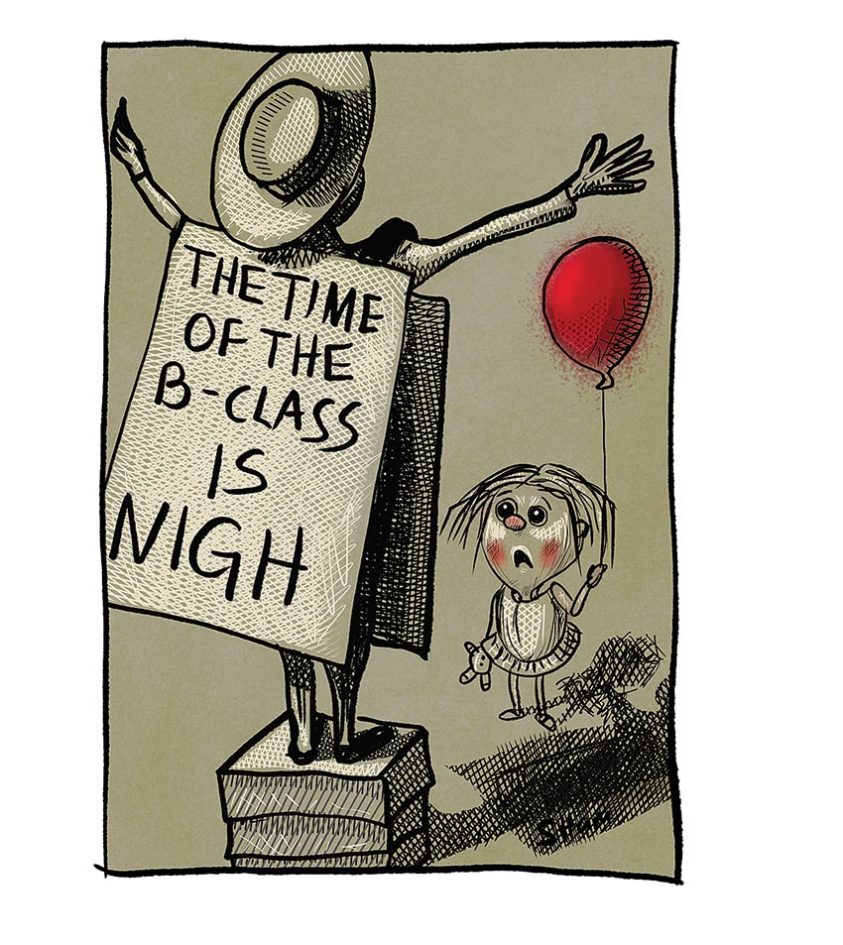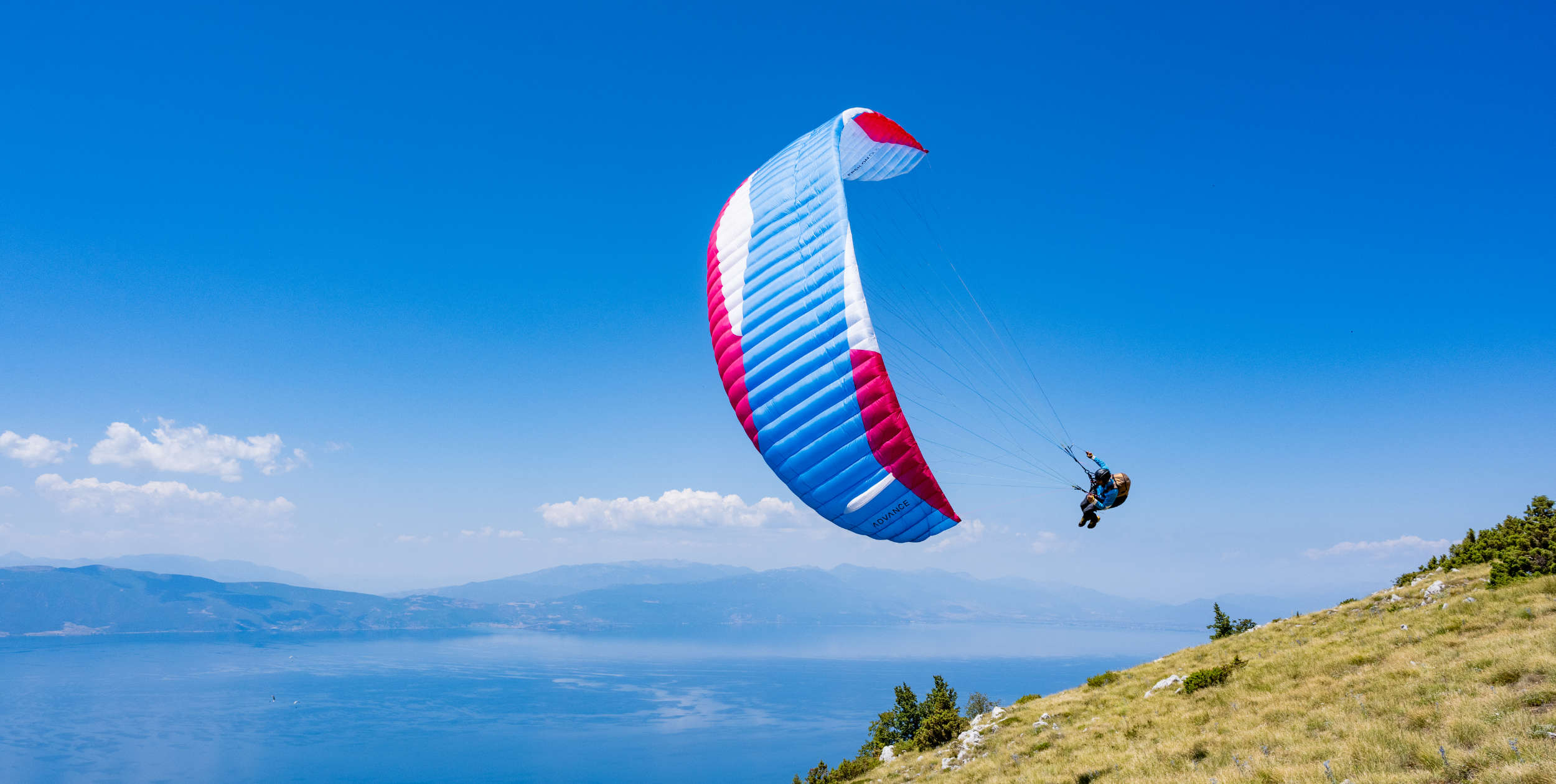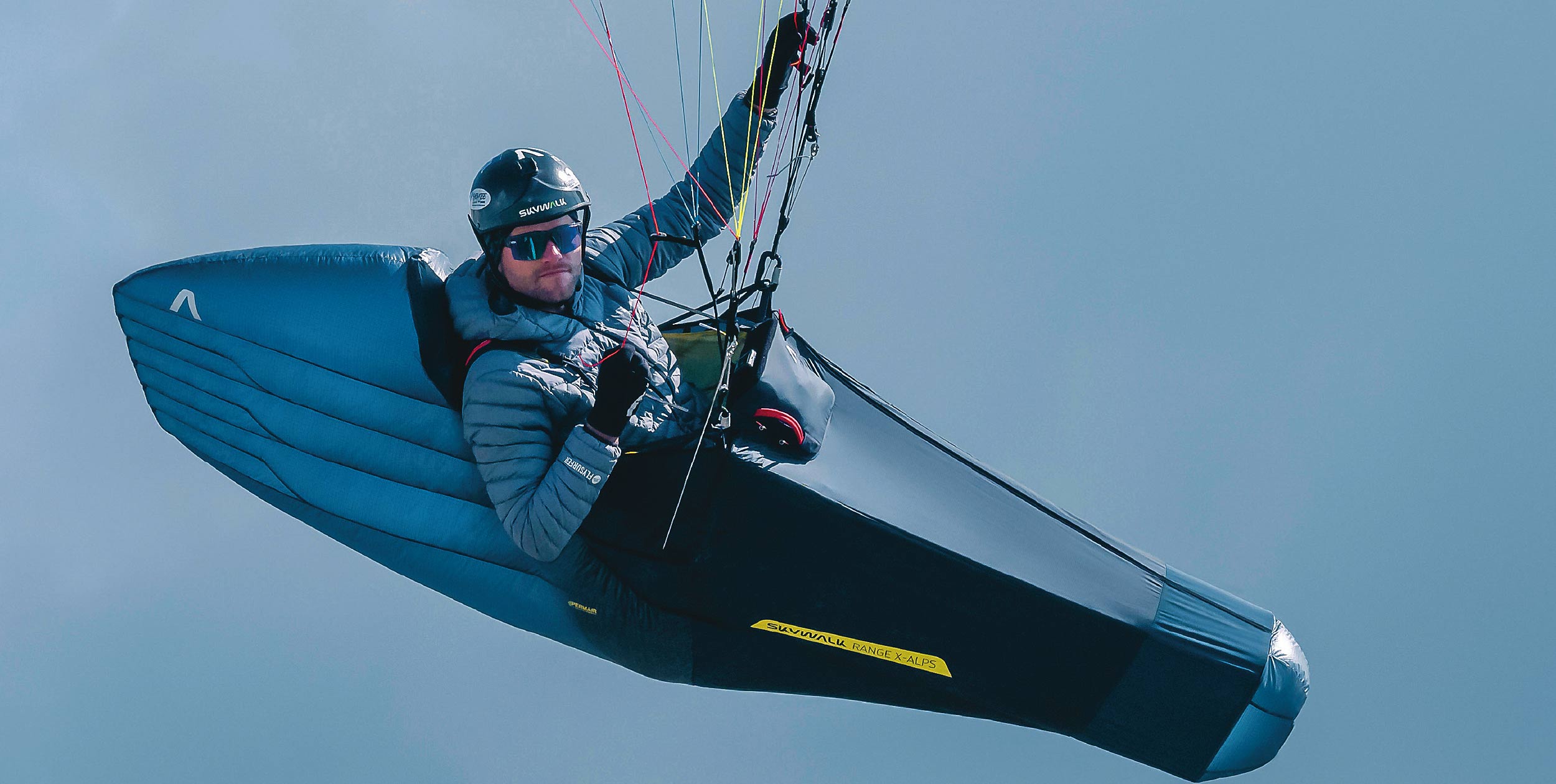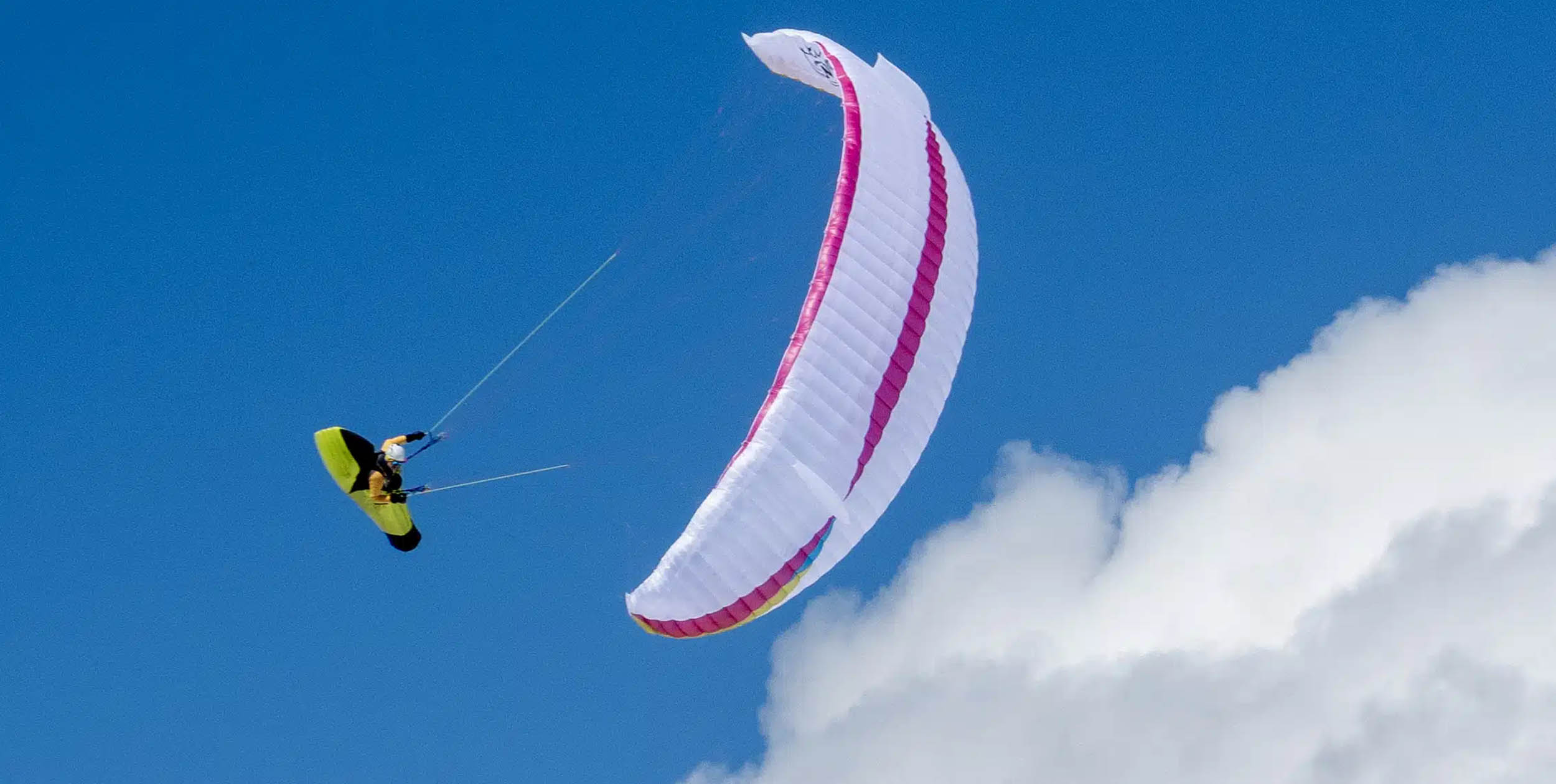“A NEW CANOPY CONCEPT with a slightly higher cell count, decent sharknose and more attention to details in the cell construction and sail tension ensure constant internal pressure along the entire angle of attack area. The result is a glider that flies like on rails, even in turbulence conditions.”
The Skywalk website description is just the sort of stuff to excite a chap like me. All the newest technology wrapped up in the comfort of a B-class package. Much of my flying is in the strong convergence across the plains of central Spain. This “flying on rails, even in turbulence” business seems just the ticket for me!
I’ve become something of a B-class evangelist over the last few years. I haven’t flown an aggressive comp wing since my last World Championships in 2007, but carried on with the D-class racers in my daily job of XC guiding, whilst still having the odd half-hearted stab at competitions.
My Damascene moment came when flying alongside Nigel Page on his Mentor 2 in 2011. His modest B-class wing seemed to go almost as well as my top-of-the-range fiddly D of the time. That got me thinking that for an ageing, nervous chap like myself, this just might be a better option.
There is of course a loss of pride when moving to a stumpier lower level glider. However, being gripped by fear as your sleek high-aspect ratio wing thrashes around you is a good incentive to swallow that pride; especially when the performance penalty seems so negligible for day-to-day XC flying.
The flying scene has changed dramatically over the last decade with XC adventures happening all over the globe every day, flown by pilots who might once have been happy with a bit of local soaring. A big part of this behaviour change has been the huge gains in performance of the B class.
I have been an XC guide since the early 1990s. Ten years ago a 100km flight was still a big achievement, yet these days club level pilots are easily making 50km to 100km flights. In 2016 we made our first group 200km+ flights on B wings. There seems little need to look beyond a B for recreational XC flying.
Anyway. I’ll get off my soapbox and back to the Chili 4.
Chili in Colombia
I received the demo Chili in January, just in time for a trip to Colombia, where I hoped to snatch a few days free flying either side of meet directing the competition in Roldanillo. I managed just one flight at home in Piedrahita before the trip. Our NW-facing main site doesn’t work too well in the winter so we had to launch from a small clearing a few hundred metres below the top to avoid the light tailwind.
My first take-off was to be on a shallow slope, nil wind and just five strides before the waist-high bushes which cover most of the mountain. I had been given the XS (70-95kg) and was right at the top of the weight range at 95kg. I had been told it would be better for me than the S (85-105kg) though I rather fancied a few extra metres to float me off before those bushes.
After a snatch reverse launch and fast run the bushes swept the bottom of my harness but didn’t drag me in. No time to appreciate much about the launch characteristics except that it seemed just fine and dandy. I expected little more than a sled ride but did manage to maintain for some minutes in an unexpected zephyr of convection and hoped that Roberto might dig himself out of the bushes after his aborted launch and get into the air in time to do some super scientific glide-ratio testing against his Advance Iota. No such luck!
First impressions can sometimes be off-putting. Muscle memory plays a significant part in our flying and if you find you need to make unexpected and unusual shifts and tweaks then it is unlikely that you will be prepared to make the effort to adapt unless the glider offers some huge performance incentives. The Chili, on that short flight, gave me a feeling of perfect normality. It seemed a very well tuned glider with delicate and direct handling, allowing me to feel out the light lift as I steered around gentle shifting thermals.
The relatively short brake travel and direct response was just to my liking. The downside of that sort of handling and sensitivity is often discovered in bigger air. Before I slip and stumble in analogy, metaphor and simile of my own I will steal a favourite of mine that I first heard from Steve Uzochukwu. He likened handling a glider in strong turbulent thermals to keeping a pair of big unruly dogs to heel on a leash.
Of course, there is just as much variety in paraglider design as there is in the breeds and temperaments of dogs. Now, your brash young competition pilot might enjoy a stroll leashed with a pair Dobermans or Pitbulls, even in a field of bunnies and squirrels running in all directions. I prefer a well-heeled dog and to feel informative tension changes along the leash as she is alerted to wildlife breaking from the undergrowth but without the wrench and need to haul back all the time.
On rails
In Roldanillo I managed to fly three days in some strong thermic conditions and on returning to Piedrahita managed to have some early spring flights getting my flying experience of the Chili to around six hours or so. I am pleased to say that, if we use the doggie literary device, our hound was well trained and obedient to the touch, even in the rowdy conditions. As for the “on rails” bit, well, it flew where I pointed it without having to keep putting in tiresome corrections in mild turbulence, so yes, good stuff!
The glider has a pleasing appearance as you look up at it (a nervous tic of mine). There is a nice clean racy look possibly due to the pattern and colour design rather than the real aspect ratio.
I was sporting the orange and blue combo. You may have noticed that Skywalk gliders are often the easiest gliders to distinguish from a distance, probably because of their use of complementary colours and a high contrast pattern. I personally think that a good deal of thought has gone into the colour and pattern design. My wife, prone to artistic criticism, thinks it’s the ugliest glider she’s ever seen!
Another often-used simile is of a glider “moving around in a block” or some such thing. Well, ditto for the Chili 4. Damn nice too! I’m far too old to be dealing with wobbly gliders whose tips boing about peeling fore and aft of their own accord. No such nonsense with the Chili 4.
Another plus is the pitch stability on entering a strong thermal. Those clever folk at Skywalk seem to have dialed in just the right amount of pitch-damping to comfort my pounding heart rate whilst keeping a good amount of feedback. I’m very partial to maintaining a fully-inflated glider over my head and perpendicular to the ground. I have the well-honed and speedy reactions of a lifelong coward when it comes to keeping it there. No need of such hard earned skills with the Chili 4. I found I had to quell my reflexes; backing off the brakes as most thermal-induced surges were manageable with just an opportune tweak.
The Princess and the Bs
When I owned a Skywalk glider some years back much was made of the Jet Flaps. Perhaps as in The Princess and the Pea, only princely, sensitive and magnificently able pilots can notice the difference they make. I regretfully am not of that class, but I do like a bit of science behind my purchase decisions. The thought that this might just make a difference when I need to make a critical landing in a tight spot soothes my overactive imagination.
This new Chili has much of the latest technological bells and whistles which make for very enticing reading on their website. As for performance it seemed to have dollops of it. I flew around with heaps of other pilots on all sorts of wings in Roldanillo. Flying around in abundant lift and good conditions does not make for accurate comparisons but I rather smugly felt that it was a match for most of the Cs around me, and with its sleek look and exact handling it was easy to imagine I were aboard something altogether much more splendid than a humble B-class wing.
****
CHILI 3 v CHILI 4
What’s the difference between the Chili 3 and the Chili 4? According to Skywalk the Chili 4 gives its pilots more precise feedback and can be steered more intuitively through the whole range of its brake travel than the Chili 3. “Effective brake travel is a little shorter and the brake pressure a little higher than with the glider’s predecessor.” We asked designers Alex Höllwarth and Stephan Gruber to explain more
How would you say the Chili 4 compares to the Chili 3?
We improved the performance and handling significantly, which was a hard task. The Chili 4 is clearly more comfortable to fly, the wing is much more direct in handling and in all conditions more willing to steer. Performance is significantly better, especially in turbulent conditions with same climbing rate. Speed is faster in trim and full speed.
Looking at the figures, it looks like the Chili 4 has slightly more aspect ratio and a few more cells than the 3, is that correct?
As we have more aspect ratio we made a little more cells to make this possible while retaining a uniform tension in the canopy. This helps especially for performance and a good feeling in turbulent air. Piloting demand is similar to the Chili 3, which was our target.
Will a Chili 3 pilot notice a big change of performance or feel in flight?
Yes, the behaviour is clearly different. First, after launching the pilot will realise the wing is much more direct, and the ergonomic place of the hands for steering is higher and at a better position. Handling feels much more direct. Pitch stability is much higher, which is what helps for turbulence performance. The turn is easier, and it’s easier to feel the air and your way to the centre of the thermal. The wingtips give feedback and let you know what is going on in the air. Pitch behaviour is much better.
You have also used slightly more robust material, and also more line overall. Can you explain what you have done there, and why?
Yes that’s true, we are using a slightly more robust material. There are a lot of countries where you don’t have nice green fields! The Chili 4 is just 300g heavier than the Chili 3 with more robust materials. We also have more line overall. The problem with two lines (span wise) is that you have disadvantageous angles in the line level when you increase aspect ratio. To solve that, you have to use a different suspension system, with three lines span wise. This produces more overall line, but with better angles and a more homogenous canopy, you can increase performance.
More generally, is it getting harder to get gains in performance in the B class?
Yes. The performance gains are getting smaller. On the Chili 3 it was easier to improve the performance as we had new technologies such as 3D shaping, less lines, rigidfoil… The big challenge on the Chili 4 was to keep the same climbing ability as on the 3, with the same ease of use and a better performance. It was really hard, but now we are very happy about the result. There are no big technological jumps in the Chili 4, instead it has been a more progressive development.
Will there be a light version?
It is planned, but no exact dates yet.
For pilots who don’t know what Skywalk is about, what is at the heart of what you do?
Skywalk builds gliders with passion. We all love what we do. When you fly a Skywalk wing first, you will recognise the precise and efficient handling. The glider totally fits into the target group. We do not try to push an EN-C rated wing into the B category. We do not release a glider before we are really satisfied with the product ourselves. This was why we took time to finish the Chili 4.
****
Manufacturer’s Specifications
What Skywalk say: “Good thing. Made. Better. A class apart.”
Use: Thermalling and XC
Pilot level: Intermediate +
Sizes (m²): 21.4, 24.6, 26.4, 28.3, 30.2
Weight range (kg): 55-77, 70-95, 85-105, 95-115, 105-135
Weight (kg): 4.9kg-6.1kg
Cells: 57
Flat aspect ratio: 5.65
Certification: EN B
Steve Ham flew the Chili 4 for six hours in thermic conditions in Colombia and Spain
To stay up to date and read our reviews first, subscribe to Cross Country



